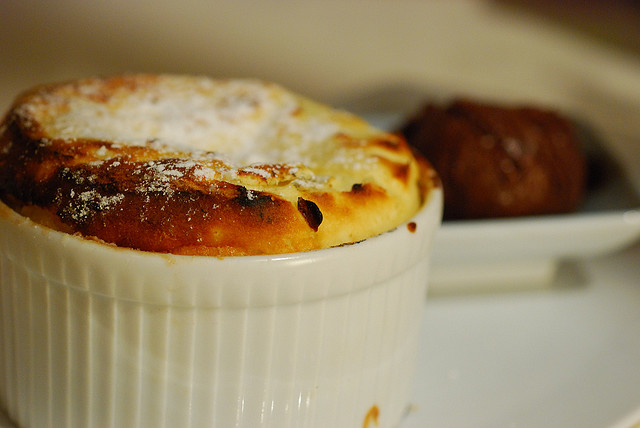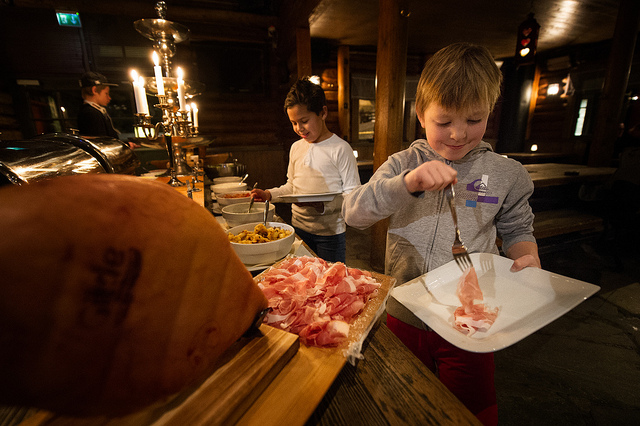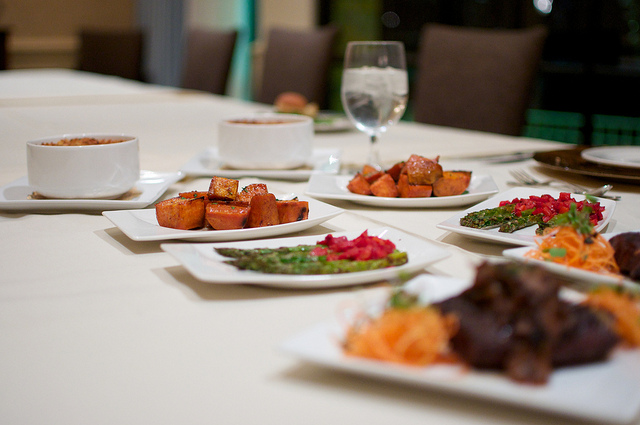The Paradox of Choice: Choosing Restaurant Menu Items
Jay Raynar from the Guardian says, “People who take ages trying to choose what to eat in restaurants don’t like food.”
But that’s not what this article is about.
(Thank goodness because we could see things getting controversial.)
This choice is for you. When it comes to ingredients, there seems to be limitless options. You want to choose the ingredients that make tastebuds do the happy dance. So you cook and you experiment. At the end of the day, you have enough recipes to create a bible-sized cookbook, but not quite an easy-to-read menu.
It is time to narrow down the list and be as ruthless as Simon Cowell. Imagine the food on the stage like in a reality competition. You want to be your own harshest critic before someone can put fork to mouth and declare, “That was just awful.” Place your standards sky high and consider these points as you develop your menu of lip-smacking delights:
Stay away from the fads.
 Cronut by Flickr, https://flic.kr/p/j7MqdK
Cronut by Flickr, https://flic.kr/p/j7MqdK
Quick. Look back at a picture of yourself in the 80s (and if you weren’t alive then, find some family throwbacks). Was anything that you were wearing at the time a good idea? Maybe.
Use fads as a interest generator but don’t put all your eggs in that fad-basket.
Try to use foods that stand the test of time. Throw in a Cronut to get those customers in the door, but have the bulk of your menu designed with ingredients that stick. Fad diets don’t lead to permanent weight loss and fad foods will likely not lead to permanent customers. Classic cuts of meat and vegetables that are beautifully prepared every time are good ways to keep some stability in your customer base.
Consider the price of ingredients.
 Flickr Image, https://flic.kr/p/7zCNfS
Flickr Image, https://flic.kr/p/7zCNfS
To balance your own profits and create reasonable price points for customers, you must determine the actual cost to make the dish. Pricey ingredients used regularly will make for a pricey menu. Some higher cost dishes balanced with lower food costs will allow for a wide variety of customers. Making the list for one of the most expensive menu items in the world is surprisingly in a NYC food truck. Their “Douche Burger” (hey, they said it) has caviar, lobster, truffles, Gruyere cheese and a champagne stuffed BBQ sauce. It is also $666 (but balanced out by the regular hamburger prices). Well played, Food Truck 666.
Easy does it.
 Flickr Image https://flic.kr/p/4DhzWj
Flickr Image https://flic.kr/p/4DhzWj
Soufflés. Coq au vin. Mole. Puff pastry. What do these things have in common (besides the fact that they are all edible)?
We know you probably cheated and checked out the link, but we will reiterate. They are all foods that are difficult to prepare.
A little bit of flare in the kitchen is certainly a good thing. But a lot of prep work for complex recipes will inevitably lead to backup in the kitchen. Create the prep recipes ahead of time and note the time it takes. Perhaps your recipe for lasagna has a sub-recipe for sauce. This will probably amount to more labor costs. Minimize the complex recipes and keep it simple as often as possible. Almost every cook, from Giada De Laurentiis to Julia Child has uttered the phrase, “Keep it simple.” They must be on to something.
Versatility Is the Name of the Game.
 Flickr Image, https://flic.kr/p/99B4Q3
Flickr Image, https://flic.kr/p/99B4Q3
If a magician does the job right, he or she has the audience on the edge of their seats, expecting the unexpected. If the same trick was repeated in every show, people would lose their fascination, no matter how amazing it was. Think the same way with ingredients. One ingredient should not have one purpose. Spinach can be salad, a pizza topper, a lasagna stuffer and a pasta bulker. Plan your menus so that a number of dishes share the same ingredients. This will cut down on the waste potential of each dish and it will make it easier for you to order food. What’s more magical than that?
Work To Your Chef’s Strengths.
 Flickr Image, https://flic.kr/p/wUG65
Flickr Image, https://flic.kr/p/wUG65
In any job, if you hire the right people and then micromanage them, they won’t be given the opportunity to show their best work. In the kitchen, you absolutely want the best work to be on display. A strength of any restaurant is the skills of the employees. Be meticulous about how each dish is prepared to ensure consistency. Insist that the final choices evoke an “Mmmm” or a “Yum.” It is the nonverbal that can tell us so much about how good food really is.
Choose quality ingredients.
 Flickr Image, https://flic.kr/p/eM1mhP
Flickr Image, https://flic.kr/p/eM1mhP
You want to consider the prices, as we mentioned, but you also want every ingredient you use to be fresh and fantastic. If strawberries don’t grow locally and don’t ship well, leave them off the menu, even if you love a spinach and strawberry salad. Expensive is not the only word that is synonymous with quality. As the average consumer learns more about diet, local and fresh foods become more important. Richard Keys, cofounder of Food & Drink resources says, “Restaurants that make the switch to fresher ingredients will reap the rewards, not only in doing the right thing for guests’ health, but in the name of flavor.” This is one “trend” you may want to get in on.
What does the area need?
 Flickr Image, https://flic.kr/p/dLxYKq
Flickr Image, https://flic.kr/p/dLxYKq
It is like when you are deciding whether or not to buy a home. After you turn on the taps and have a home inspection, you start to look further. Who are your neighbors? What is the school like? As the restaurant is your baby, you don’t want to send it to school without at least a moderate chance of success. Look around the neighborhood and take note of what would be unique. If it is swarming with pizzerias and you decide to do the same, notice what is lacking on their menus. If you see no restaurants in the area, be a detective and do some sleuthing (magnifying glass optional). It could be safety or it could be the fact that your desired neighborhood is not zoned to permit restaurants. Whoopsie.
Try and Try Again
 Flickr Image, https://flic.kr/p/9apfaL
Flickr Image, https://flic.kr/p/9apfaL
So you love your menu. Your mother loves your menu. It is time to expand your circle. Invite the pickiest people you know to a tasting. Get the people who say the honest answer to the question, “Do I look fat in this?” Take notes. Take their opinions down. Revise. Try again. After the menu is printed, you want to give it a good run, but before that moment you want to be ruthless. Even if something worked in theory, if it is not tantalizing your customers, it must go.
The menu that remains will be a work of art. It will be a thing of pride. And most likely, you will never look at any menu the same way again.


